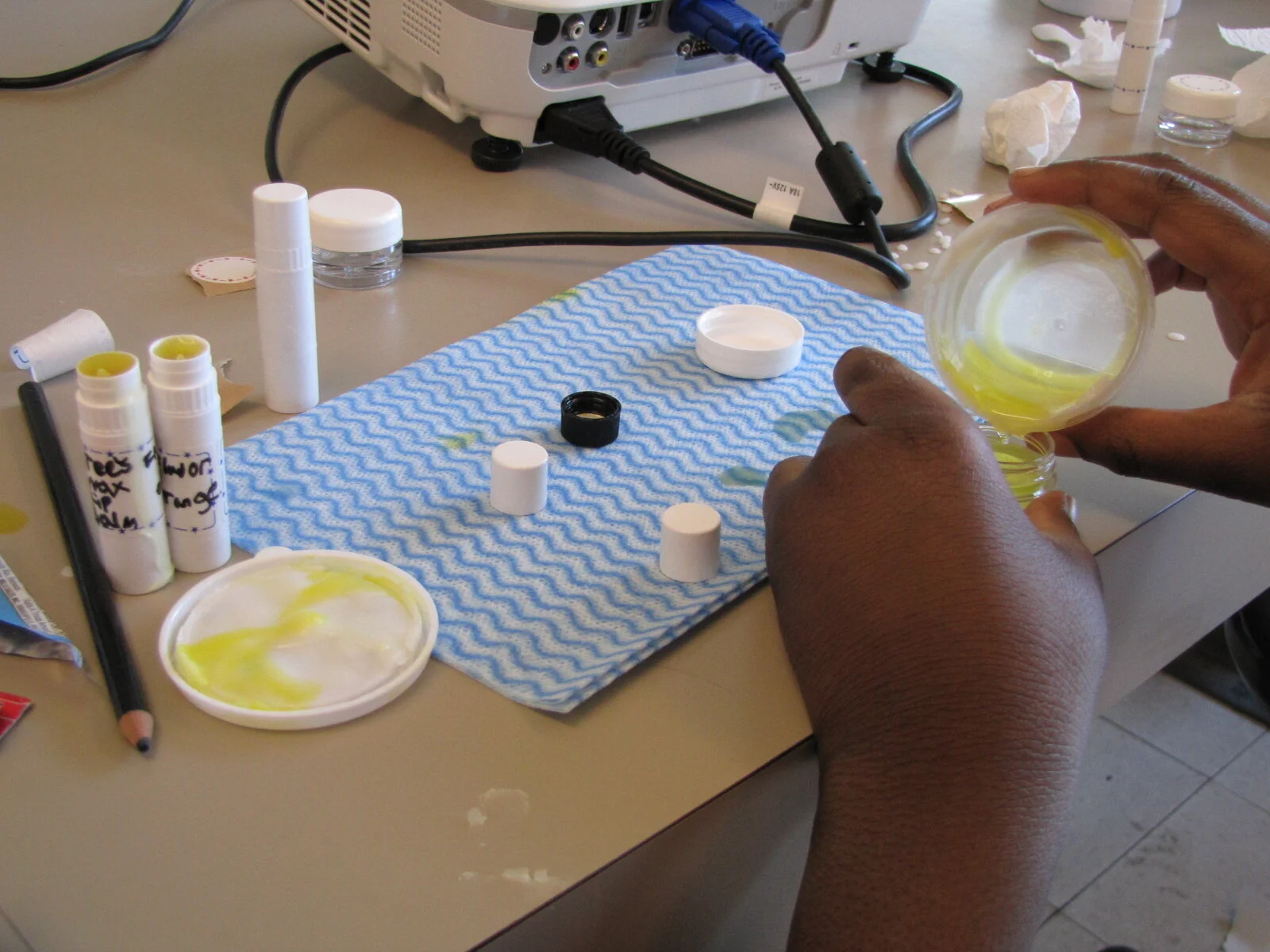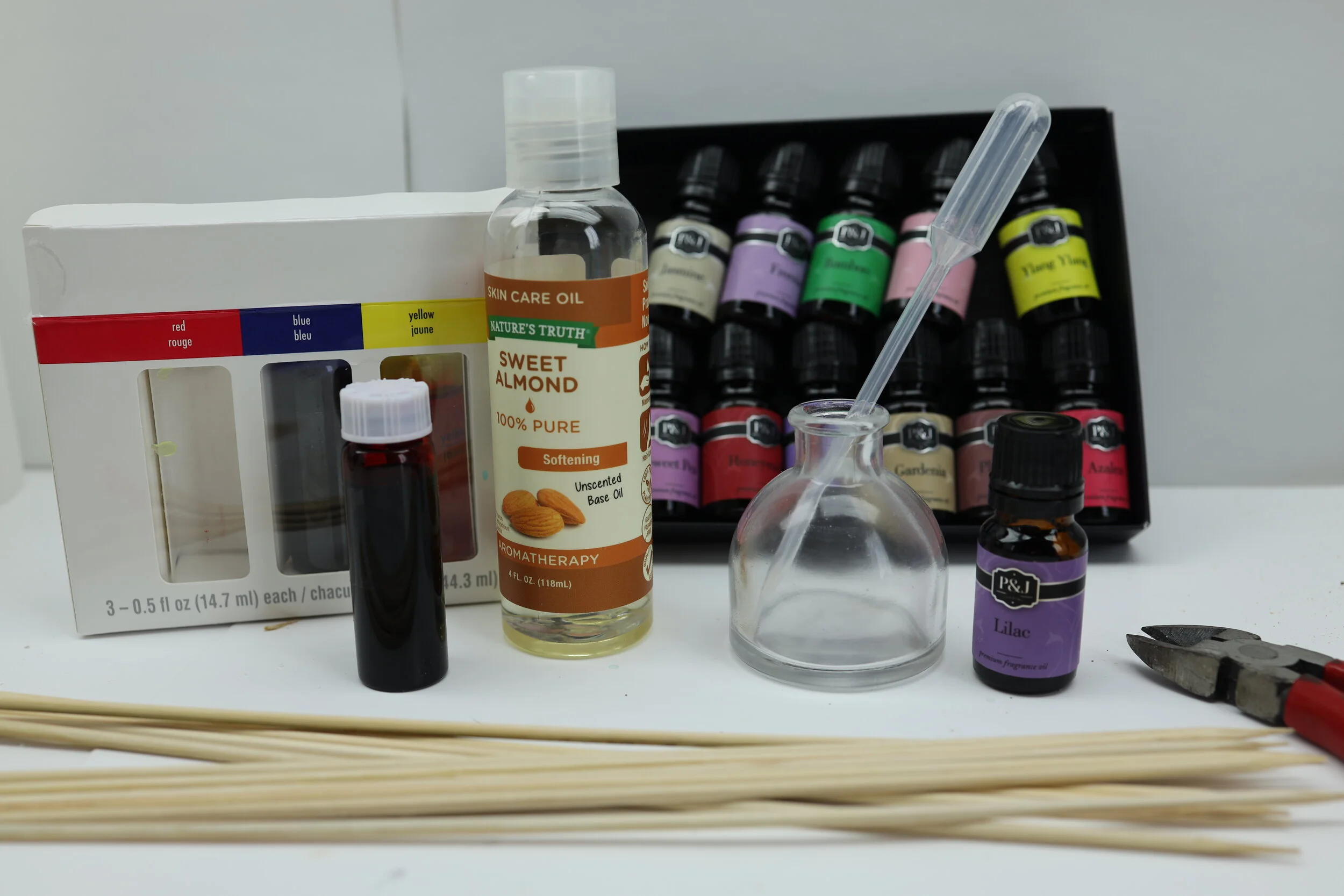Students love making lip balm allowing them to examine and mix cosmetic chemicals like beeswax, shea butter, coconut butter, and almond oil with small amounts of flavoring and color to make their own lip balm. The lecture covered the origin and chemical structure of each ingredient and then the students mixed, melted, and poured their formulas into cosmetic application containers. The student took home their products allowing them to enjoy the works of their own hands.
Material Needed for Reed Oil Diffuser
One reed oil diffuser is made from a 2-oz. bottle ($1.37), sweet almond oil ($7.00), essential oil ($6.75), and bamboo skewers ($6.88). The sweet almond oil is an odorless carrier used to dilute the essential oil. Other odorless vegetable oils like sunflower oil can be used as a carrier. Candle lipophilic dye was only added to see the oil migrate up the reeds,
Major Componets in Oil of Lilac
(E)-ocimene is the major component of lilac, but furanoid terpene aldehyde (lilac aldehyde) and the corresponding alcohol, benzyl methyl ether, 1,4-dimethoxybenzene (hydroquinone dimethyl ether) and indole are the most characteristic components. The compound benzyl methyl ether is said to influence the diffusive aura of lilacs, especially in full bloom.
The Oil Reed Diffuser for Release of Essential Oils
An essential oil reed diffuser is a simple device that allows one to release the essence of Lilac into a room. The reed diffuser is one of simplest setups for essential oils and has the advantage of not requiring power while providing long periods of release. A two ounce bottle is filled with 1.5 ounces of sweet almond oil and 0.5 ounces of essential oil. Red dye is added in this instance to show the capillary action of the oil up the reeds. Once the oil migrates up the reed, the fragrance chemicals in the oil diffuse into the environment. The oil diffuser last for days and weeks.
The Chemistry of Oil of Lilac
Chemists Zhao et. al. created this chromatogram of oil of lilac. Each peak along this chromatogram is a different compound separated from oil of lilac. They identified 95 volatile compounds in the essential oil. Essential oil are complex mixtures like the oil of lilac and the number, kind, and amount of compounds vary from plant to plant and from species to species. So, like fine wines each batch has it our qualities and vintage.
Essential Oil of Lilac
Essential oil of Lilac is an oil that contains the chemistry essence of the lilac flower. The adjective “essential” used with the noun oil does not carry the common meaning of the word, i.e. “to be absolutely necessary or extremely important.” Instead, essential means to contain the essence of lilac. Essential oils contain the scents of the flower. Some would disagree that color, not scent, is the essence of a flower. However, both color and scent are used by the plant to attract insects for pollination. The scent of flower is directly attractive to human and also instinctively associated with spring growth and plant reproduction, because soon after the smell of flowers come the seeds and harvest of the plant for human consumption and survival during the history of mankind.
Reprogramming your brain to overcome fear: Olympia LePoint at TEDxPCC
Here is a motivational TED talk relevant to young science students.
This Experiment Made Acid and Base Solutions from pH 0 to 14 from Household Chemicals and Observed There Effect on the Color of Red Cabbage Juice
In conclusion: This experiment explored acid and base solutions made from household chemicals from pH 0 to 14 and observed their effects on the color of red cabbage juice. Three theories of acids and bases were introduced and the characteristics of acids and bases were described. Finally, the toxic effects of low and high pH solutions were discussed.
Drano Produced a pH of 14 and Turned the Cabbage Juice Green
Drano is the commercial name for sodium hydroxide, a strong base. Sodium hydroxide should only be handled by adults trained in it use wearing gloves and eye protection. A teaspoon of solid sodium hydroxide dissolved in the cabbage juice produced a pH of 14, the highest possible pH. Note that in the picture, the stem of the glass the sodium hydroxide concentration so strong that it started to degrade the juice itself into a yellow substance. Sodium hydroxide is an example of a strong Arrhenius base that dissociates 100% in water. The single arrow in the equation mean the dissociation goes 100% into ions.
The Lewis Theory of Acids and Bases
The Lewis theory of acids and bases extends well beyond the things you normally think of as acids and bases and states that…
A Lewis acid is an electron pair acceptor
A Lewis base is an electron pair donor
The reaction above contains both a Lewis diagram of ammonia and boron trifluoride, and also is an example of a non-aqueous Lewis acid and base reaction not addressed by the other theories
https://en.wikipedia.org/wiki/Gilbert_N._Lewis
Bronsted-Lowry Theory of Acids and Bases
The Brønsted-Lowry theory of acids and bases states that …
A base is a proton (hydrogen ion) acceptor.
An acid is a proton (hydrogen ion) donor.
In the reaction of HCl + H2O -> H3O+ + Cl-, HCl donates a proton and water accepts a proton fitting into the Bronsted-Lowry theory as shown in the image on the photos.
https://chem.libretexts.org/Bookshelves/Physical_and_Theoretical_Chemistry_Textbook_Maps/Supplemental_Modules_(Physical_and_Theoretical_Chemistry)/Equilibria/Acid-Base_Equilibria/1._Theories_of_Acids_and_Bases
The Arrhenius Theory of Acids and Bases
The Arrhenius theory of acids and bases states that…
Bases are substances that produce hydroxide ions in solution.
Acids are substances that produce hydrogen ions in solution.
The equation on the left shows an Arrhenius acid, hydrogen chloride produces a hydrogen cation in water. The equation on the right shows an Arrhenius base. Sodium hydroxide produce a hydroxide anion in solution.
https://upload.wikimedia.org/wikipedia/commons/thumb/9/92/Svante_Arrhenius_01.jpg/220px-Svante_Arrhenius_01.jpg
Four Founders of Modern Acid-Base Theory
Four of the preeminent founders in the theory of acids and bases were Arrhenius, Bronsted, Lowry, and Lewis. These four Western scientists influenced our modern body of knowledge in chemistry. There are three basic theories on acids and bases: the Arrhenius, Bronsted-Lowry, and Lewis. The cabbage juice experiment will be evaluated against these three theories.
https://2.bp.blogspot.com/-6UoTz5u9x6U/VvElF_BdpgI/AAAAAAAAACA/UcT80pvK6m0RNRhkvccNZmAgYOrxJRIKg/s1600/slide_3.jpg
Clear Ammonia Produced a pH of 11 and Turned the Cabbage Juice Green
Ammonia has the chemical formula NH3, made out of nitrogen and hydrogen. Ammonia was first associated with the breakdown smell of decaying urine. Now it is made in chemical engineering plants. Ammonia is an example of a Bronsted-Lowry base, any compound that accept a proton, H+. Note that ammonia does not contain a OH- anion associated with a base solution. However, as shown in the equation in the picture, when ammonia is mixed with water as a Bronsted-Lowry base it accepts a proton, H+, from water leaving behind the OH- anion and thus creates extra OH- anions in solution with a pH of 11.
Milk of Magnesia Produced a pH of 10 and Turned the Cabbage Juice Blue-green
Milk of Magnesia is an over-the-counter medicine for upset stomachs. The chemical name is magnesium hydroxide with the formula Mg(OH)2. This is the first example of a classical Arrhenius base, a base that gives off an OH- anion directly from its molecule. The excess OH- anions given off by Mg(OH)2 as shown in equation in the picture is what makes the solution basic with a pH of 10. Magnesium hydroxide is a weak base as represented by the double arrow that means not all the molecules on the left side of the double arrows separate 100% into ions.
Two Definitions of Acid and Bases
The Arrhenius definition of acids and bases dates back to 1884, and the Arrhenius definition is that an acid is a compound that dissociates into H+ ions in water solution and that a base is a compound that dissociates into a OH- ion in water.
The Bronsted-Lowry definition of an acid is that it is any compound that donate a proton and a base is any compound that accepts a proton. One main difference in these two definition is that a proton acceptor can be other than OH- and the definition also work in non water solutions. So, these bases don’t have to give off OH- directly.
Dish Soap Produce a pH of 9 and Turned the Cabbage Juice Dark Blue
This dish soap contains sodium methyl 2-sulfolaurate/disodium 2-sulfolaurate. Sodium methyl 2-sulfolaurate/disodium 2-sulfolaurate is derived from coconut oil and acts as a surfactant and foaming agent. The chemical structure to the left of the sample is sodium methyl 2-sulfolaurate. The chemical structure to the right of the sample is disodium 2-sulfolaurate. In both cases, the anion head of the organic molecule (red in color) acts as a base and attracts the proton from water leaving behind a hydroxyl anion the excess of which creates a pH of 9 and turns the cabbage juice blue. The way the sulfolaurate anion generates OH- from water is similar to the way the hydrogen carbonate anion generated OH- anions with water in the baking soda example.
https://pubchem.ncbi.nlm.nih.gov/compound/Sodium-Methyl-2-Sulfolaurate
Baking Soda Produced a pH of 8 and Turned the Cabbage Juice Blue
Baking soda is also called sodium bicarbonate or officially, by its IUPAC name, sodium hydrogen carbonate, and has the formula show in the picture. IUPAC is an abbreviation for the International Union of Pure and Applied Chemists. The equation below shows sodium hydrogen carbonate dissociating into a sodium cation and hydrogen carbonate anion. The hydrogen carbonate anion, in turn, hydrolyzed into carbonic acid and a hydroxyl anion. It is the excess hydroxyl anions (OH-) that turned the water basic and give the solution a pH of 8 with excess OH- anions.
Table Salt Did Not Change the Color of Cabbage Juice and Was Assumed to Have a pH 7
Table salt or sodium chloride with the formula NaCl has no acid or base properties whatsoever. When added to water, sodium chloride is neutral and the pH does not change. Table salt also has no buffering properties. A buffer is a salt solution that can resist change in pH when acid and base is added. Table salt is neutral. The glass was labeled pH 7.0 assuming the water was pH 7.0 to start and did not change when salt was added. It probably had a little carbonic acid in the juice.
Water Produced a pH of 6.5 and Turned the Cabbage Juice blueish Color
Why is the pH of pure water 6.5? Pure water is suppose to have no acid or base added, and theoretically the pH should be 7. Pure water breaks down by itself into a small amounts of hydrogen cations and hydroxide anions (see figure below glass), one ion of each for every ten million (10,000,000) molecules of water, and the number of hydrogen and hydroxyl ions are equal and balanced, in other words, pH balanced to pH 7. So where does the pH 6.5 come from? Pure water upon standing absorbs carbon dioxide creating carbonic acid. Pure water has a pH of 6.5, because it contains some carbonic acid. https://en.wikipedia.org/wiki/Self-ionization_of_water

















